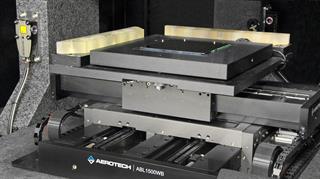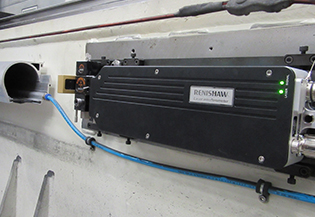Why use a laser interferometric encoder?
High accuracy
The laser interferometer is so far the most advanced technology used for precision feedback. It is able to offer the finest resolution and highest accuracy. The diagram below shows how different technologies fit in the accuracy scale.

Contactless measurement
Other technologies rely on the physical scales, which unavoidably associated with wear and tear. The contactless laser interferometer measurement method eliminates the mechanical deterioration of the system.
Point of interest measurement
Due to the mounting consideration, most linear encoders are often “buried” inside the positioning stage, some distance away from the work piece introducing an additional source of error (known as Abbe error). Laser interferometer without physical scale, has the freedom of being mounted to directly measure the displacement at the point of interest.
Why use Renishaw's laser systems?
Superior wavelength stability
With laser interferometer technology, the wavelength is the basic unit that represents the measuring distance. The wavelength stability therefore is directly correlated to the measurement repeatability. The laser tubes used by Renishaw are referenced against the ones certified by National Physics Laboratory (NPL) to ensure that they meet the best possible wavelength stability standards. As a result, Renishaw laser interferometers deliver the most repeatable performance.
| Timeframe | RLU20 | RLU10 | HS20 |
| 1 minute | ±1 ppb | ±10 ppb | - |
| 1 hour | ±2 ppb | ±0.05 ppm | - |
| 8 hours | ±20 ppb | ±0.05 ppm | ±0.05 ppm (8 hours) |
Intrinsically high resolution
The measurement reference of the Renishaw encoders is internationally recognised wavelength of HeNe. At 633 nm, this is much finer pitch than typical optical encoders. It enables the Renishaw encoders to easily achieve high resolution (up to 9.64 pm).
Minimised errors
The innovative design of Renishaw laser encoders employs various advance technologies to minimise errors from different sources to achieve the highest precision. Those technologies include the environmental compensation system, correcting the wavelength changes in a varying environment; the sophisticated electronic design and optical schemes that enables the lowest SDE (<±1 nm) and the advanced laser wavelength stabilisation scheme.
Flexible choices of data format
Renishaw laser encoders offer the choices of different output, including intrinsic analogue signal and different resolution options for digital data format. This enables the flexibility to integrate precision feedback into a number of different systems.
Why use Renishaw Laser Encoders (RLE)?
Quick to set-up and easy to align

Conventional laser interferometer schemes use a separate laser head, interferometers, retro-reflectors and detector units. The laser beam is routed between these isolated components by a complicated network of beam splitters and benders, resulting in a bulky, complex system which is time consuming and difficult to set up, align and maintain.
RLE uses optical fibre to deliver the laser beam directly to remote launch units which also contain the interferometer optics and detector. This method gives the RLE a number of critical advantages that minimise integration time and system complexity:
- System footprint is dramatically reduced – using the miniature launch unit (RLD) as the measurement reference with only the mirror/reflector mounted onto the motion system.
- The laser head can be mounted remotely from the measurement axis eliminating a potential heat source within the working area of the machine.
- Complicated beam routing optics become redundant, reducing alignment to just two components (RLD and measurement optic).
- Incorporated beam steerers into each launch unit; provide beam adjustment for rapid alignment to the axis of motion.
High resolution
Like the pitch of encoders, the wavelength of laser interferometers determines how fine the resolution can be. Based on the laser of 633 nm wavelength, the Renishaw laser interferometer can easily achieve an inherently high resolution with minimum SDE (interpolation error).
Exceptional performance
The performance of the RLE excels not only in its system accuracy. But equipped with cutting-edge signal processing unit, it provides the user with sub-nanometre resolution capability at velocities of up to 2 m/sec for axis lengths of up to 4 m.
Why use HS20?
Capable of working in harsh environments

The robust anodised aluminium enclosure of HS20 fully seals the internal optics and electronics to the IP43 standard. This enables HS20 to operate in a harsh machine shop environment, where there are continuous scatterings of dirt, oil, swarf and water.
A complimentary ducting system is available to minimise the air turbulence along the laser measurement path and protect external interferometer optics from obstructions and dirt. This way it helps to maintain optimum signal strength level and prolonging life expectancy of the interferometer system.
High performance
HS20 allows position to be determined over a range of up to 60 m at a speed as high as 2 m/s and with a resolution at a nanometre level, available in analogue and digital quadrature directly from the laser head.
Easy to set up
Aligning various components of a laser interferometer system is historically difficult, it can take up to hours. With a robust and easy-to-use alignment mechanism (using the HS20 alignment plate), Renishaw enables users to set up HS20 with ease to save time.